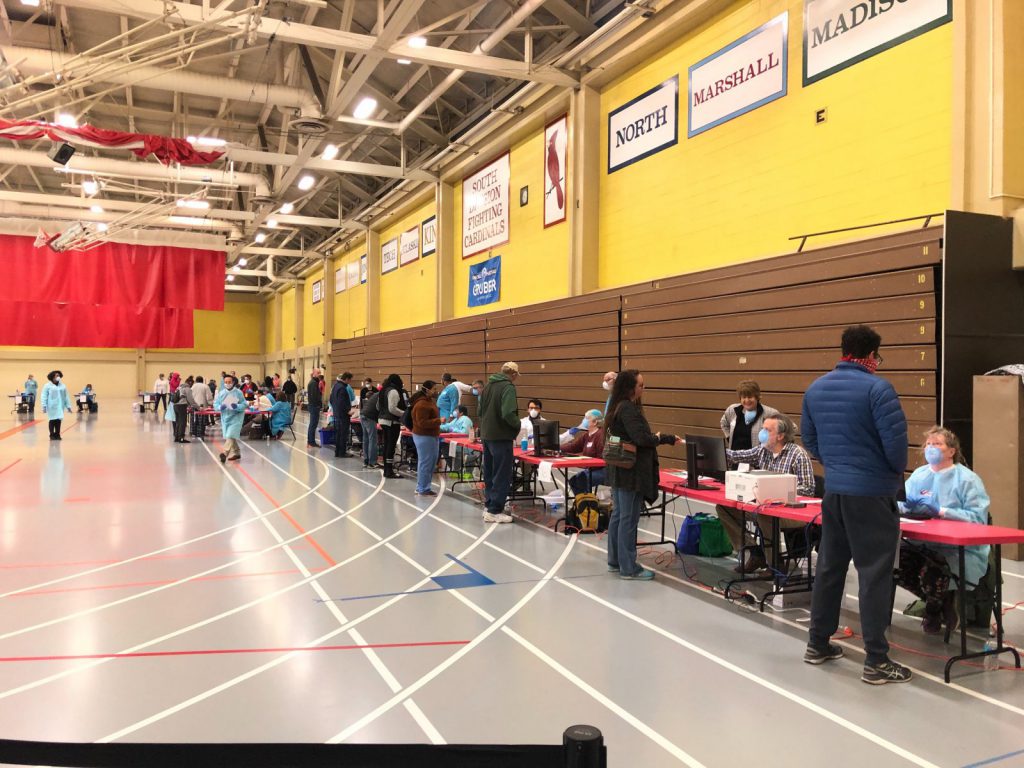12 Election Takeaways
How high was turnout, lawyers will be busy, girl power, streetcar wins again and a new council president?
We have now lived through the most unusual election in Wisconsin history, if we are to believe it’s over. A number of lawsuits could call that into question.
The COVID-19 pandemic resulted in the biggest by-mail absentee vote count in state history (over one million ballots), but thousands of voters never received their ballots.
Things got more complicated by Governor Tony Evers ordering in-person voting suspended, the Wisconsin Supreme Court ordering it back on and the US Supreme Court revising absentee ballot due dates set by a lower court. And that happened in just a single afternoon.
Further compounding the problems, the City of Milwaukee only had enough staff to open five polling places, down from 180, with wait times of over two hours at one site.
“This is voter suppression at its worst,” said national Democratic Party chair Tom Perez Monday morning. And while I won’t attempt to assess the validity of that claim in my election takeaways below, suffice it to say this election was not what democracy should look like.
Let’s dissect what we actually know.
1. Tom Barrett Remains a Popular Pol
Since first being elected mayor in 2004 in a close election (54-46), Tom Barrett has been very popular with voters.
He landed 79 percent of the vote in 2008, 70 percent in 2012, 70 percent in 2016 and 63 in 2020. State Sen. Lena Taylor came closer than those before her, but it’s hard to unseat an incumbent mayor in Milwaukee.
There is another number, however, that will likely keep him from appearing on the ballot again in 2024 – 70. That’s how old he will be at the end of this coming term.
Barrett is the longest-serving mayor of a big city in America, but he’ll have to run for re-election again if he wants to tie Henry Maier as the longest-serving mayor in Milwaukee history.
2. Lawyers Will Get Plenty of Work
There is already one lawsuit filed as a result of the election, a catch-all class-action suit filed Monday that touches on virtually every issue that prevented voters for casting ballots.
But more suits are likely to come with thousands of candidates on the ballot across the state. Taylor conceded her race to Barrett, but promised a lawsuit in her concession speech. “We will be following with a suit to deal with the disenfranchisement of people,” said Taylor. Her previous suit to delay the election was dismissed.
Senator Chris Larson, who according to unofficial results is 0.54 percent behind Representative David Crowley for a four-year term as Milwaukee County Executive, isn’t conceding. “We are weighing all options in this,” said Larson as the final votes were being counted.
Crowley was up by approximately 1,000 votes when the Milwaukee County Election Commission reported 480 out of 480 wards reporting. Then the commission confirmed approximately 17,000 ballots needed to be loaded in-person from Wauwatosa and Franklin because of issues with modems on their voting machines. But after those ballots were counted, Crowley was still 1,000 votes ahead.
If the results stand, and Crowley survives any possible recount, he would be the first African-American elected county executive in Milwaukee.
Even if the county race doesn’t end up court, other lawsuit angles remain. The Milwaukee Election Commission and other municipalities voted to accept ballots without postmarks. Ballots were received by voters after election day. Other ballots never arrived at all.
3. How Strong Was Turnout?
Initial data suggested Milwaukee turnout was going to be far lower than expected. How did that end up? A little bit better than expected.
In total, 95,166 Milwaukeeans cast ballots in the April 7th Spring Election. That beat the city’s 2019 total of 68,770, which featured a state supreme court race and not much else. It also bested even lower totals from 2018 and 2017.
Milwaukee Election Commission Executive Director Neil Albrecht estimated earlier this month that approximately 140,000 Milwaukeeans could vote in this year’s spring election. But the total ended up nowhere close to that.
It did end up more in line with the 2008 spring election where 86,641 ballots were cast. Interesting data point: Lena Taylor ran in that race, too, getting 44,952 votes for Milwaukee County Executive.
Overall, fewer votes were cast in Milwaukee (95,166) than absentee ballots requested (96,712), which should raise alarm about the effectiveness of switching to an all absentee election. A total of 18,803 people voted in person.
Statewide over 1.55 million voters cast a ballot. The total was ahead of the 2019 total (1.2 million) but far below 2016 (2.1 million). Both of those totals are dwarfed by the approximately three million ballots cast in each of the past two Presidential elections.
4. From COVID-19 to City Attorney
The biggest upset of the night was undoubtedly Tearman Spencer upsetting 36-year-incumbent Grant Langley for city attorney. Spencer, who was bed-ridden with COVID-19 for much of the final weeks of the campaign, had a surprise showing in the primary and carried that momentum into the general election.
He’ll be the first African American to hold the office, and the first person to redecorate it in my entire lifetime. He’s going to have plenty of work to do. He’s trading his solo law practice in the Colby Abbot Building for one with 38 attorneys at City Hall.
5. Sawa Edges Out Fields
While there is going to be a new city comptroller in Milwaukee, don’t expect a radical departure from the last. Deputy Comptroller Aycha Sawa won a race to replace her retiring boss Martin Matson. She defeated State Representative Jason Fields by 50.4 percent to 49.18 percent.
The race featured more spending than expected with a political action committee, Leaders for a Better Community, spending heavily on mailers to attack Sawa and promote Fields.
The mailers accused Sawa of blocking an audit of the city’s lead service lines and ending up in a criminal investigation, but that investigation was actually of the Milwaukee Health Department.
The comptroller, in effect the city’s chief financial officer, exercises financial control over virtually every aspect of city government including public debt and employee pay. The comptroller also provides audit services and financial analysis of every proposed tax-incremental financing district.
6. No Council Upsets, but the Council Will Be Upset
The 13 members of the Milwaukee Common Council running for re-election all won. But the power balance of the Common Council could shift. Ashanti Hamilton replaced Michael Murphy as president in 2016 by allying with Robert Donovan, Mark Borkowski and Tony Zielinski. But neither Zielinski nor Donovan ran for re-election
The far more liberal Marina Dimitrijevic and JoCasta Zamarripa will replace Zielinski and Donovan and with that Hamilton could lose his gavel.
There is also one more dynamic that could change the body’s operation…
7. Girl Power
The 15-member Common Council will now include five women, the highest total in its history. Dimitrijevic and Zamarripa join Nikiya Dodd, Milele A. Coggs and Chantia Lewis. The previous record was four in 2000.
8. Justin Bielinski Just Misses Again
Community organizer Justin Bielinski put a lot of work into his aldermanic campaign against Donovan in 2016, but ultimately came up short by 161 votes. Donovan, who was simultaneously running for mayor and alderman, no doubt benefited from the advertising on his mayoral campaign.
But with Donovan retiring and Bielinski already waiting in the wings to run, he was a shoo-in, right? Not quite. Bielinski lost by 92 votes to State Representative Zamarripa. A total of 166 people cast ballots in the district, but didn’t vote in that specific race.
One strange takeaway from the race: how low voter turnout is in the 8th District. In 2016 the district voted 2,260 to 2,099 for Donovan. In 2020 it went 1,104 to 1,012 for Zamarripa. Even if you combine the 2020 total for both candidates, you still don’t get a sum as large as the winner’s total in any of the city’s contested council races.
9. People Like Milwaukee Public Schools
It’s pretty easy to strike up a conversation with a Milwaukee Public Schools teacher and get them to be critical of the district. But you’ll quickly find that the typical teacher also cares deeply about their students.
Voters apparently feel the same way. A referendum to provide MPS with an additional $87 million annually with very few strings attached passed on a 78-22 margin. There was no organized opposition to the effort and groups like the Greater Milwaukee Association of REALTORS even endorsed the proposal.
10. Don’t Run Against the Streetcar
Free campaign advice for Milwaukee candidates: don’t make opposition to the streetcar a central point of your campaign.
Since The Hop was first proposed in 2011 not a single pro-streetcar politician has lost to one opposed to the system. That trend continued in the latest election.
Barrett beat Taylor, who framed the issue as proof the mayor allegedly cared only about rich downtown residents.
Dimitrijevic, who has spoken in favor of expanding the system, beat Jason Auerbach for an open seat once held by Zielinski, who vocally opposed the streetcar after voting for it in 2011. Zielinski made opposition to it a central point of his mayoral campaign and ultimately came in third in February. Auerbach has been critical of The Hop’s creation.
11. Did Bernie Sanders Help Elect Karofsky?
Former Vice President Joe Biden went into the election as the presumptive Democratic Presidential nominee and the next day Senator Bernie Sanders dropped out of the race, cementing Biden’s status.
But the illusion of a race could have benefitted liberal Wisconsin Supreme Court candidate Jill Karofsky. Despite being all but eliminated, Sanders still pulled in 32 percent of the vote in Wisconsin.
Without a Democratic Presidential primary does Karofsky get 855,981 votes (55 percent)? Hard to say.
She did win swing counties like Winnebago and Kenosha that last went to conservative Justice Brian Hagedorn.
But she didn’t receive the vote of every Democratic voter. All of the Democratic Presidential candidates received 923,759 votes. Conservative incumbent Justice Daniel Kelly (692,523) pulled in more votes than President Donald Trump (616,705), but Trump was running unopposed for the Republican nomination.
It is safe to say that Sanders’ timing of suspending his campaign right after the election, instead of right before, certainly didn’t suppress turnout.
12. Court’s 5-2 Majority Becomes 4-3
Karofsky won a 10-year-term on the Wisconsin Supreme Court, adding another liberal vote to the seven-member court and switching the conservative majority from 5-2 to 4-3. Karofsky defeated Kelly, who was appointed by Governor Scott Walker to fill out the term of retired Justice David Prosser.
And with that one-vote majority, you’re going to want to mark your calendars for April 2023. Chief Justice Patience Roggensack, a conservative, is up for re-election.
Expect both the Democratic and Republican parties to spend heavily in a race that is increasingly partisan despite its non-partisan label.
If you think stories like this are important, become a member of Urban Milwaukee and help support real, independent journalism. Plus you get some cool added benefits.
More about the 2020 Spring Primary
- Why Don Natzke Couldn’t Vote - Enjoyiana Nururdin - Aug 9th, 2020
- Centers for Disease Control and Prevention’s Morbidity and Mortality Weekly Report highlights public health measures taken by the Milwaukee Health and Fire Departments, Department of Administration, Election Commission, and the Wisconsin Department of Health Services - City of Milwaukee Health Department - Aug 4th, 2020
- CDC Says Election Did Not Cause COVID-19 Spike - Erik Gunn - Aug 4th, 2020
- Pandemic Reduced Black Vote, Study Finds - Dee J. Hall - Jun 25th, 2020
- Did April Election Hike COVID-19 Cases? - Alana Watson - May 20th, 2020
- Elections Commission Notes ‘Lessons Learned’ - Henry Redman - May 19th, 2020
- Wisconsin Elections News: WEC Releases Analysis of Absentee Voting in April 7 Spring Election - Wisconsin Elections Commission - May 18th, 2020
- Election’s Impact on County’s COVID-19 Cases Unclear - Jeramey Jannene - May 6th, 2020
- Why State’s Voting By Mail Was Chaotic - Daniel C. Vock - May 4th, 2020
- At Least 40 COVID-19 Cases Tied to Election in Milwaukee - Graham Kilmer - Apr 24th, 2020
Read more about 2020 Spring Primary here
Political Contributions Tracker
Displaying political contributions between people mentioned in this story. Learn more.
- January 28, 2020 - Aycha Sawa received $500 from Martin Matson
- December 31, 2019 - JoCasta Zamarripa received $50 from Nikiya Dodd
- December 31, 2019 - Marina Dimitrijevic received $50 from Nikiya Dodd
- December 31, 2019 - Milele A. Coggs received $250 from Tearman Spencer
- November 23, 2019 - Aycha Sawa received $200 from Martin Matson
- October 9, 2019 - Aycha Sawa received $1,000 from Martin Matson
- April 24, 2019 - JoCasta Zamarripa received $50 from Tony Zielinski
- March 26, 2016 - Chantia Lewis received $50 from Nikiya Dodd
- March 26, 2016 - Chantia Lewis received $50 from Nikiya Dodd
- March 9, 2016 - Justin Bielinski received $100 from Tom Barrett
- January 13, 2016 - Ashanti Hamilton received $10 from Chris Larson
- January 13, 2016 - Ashanti Hamilton received $20 from Nikiya Dodd
- December 30, 2015 - Milele A. Coggs received $10 from Chris Larson
- December 30, 2015 - Milele A. Coggs received $20 from Nikiya Dodd
- September 8, 2015 - Robert Donovan received $50 from Mark Borkowski




















